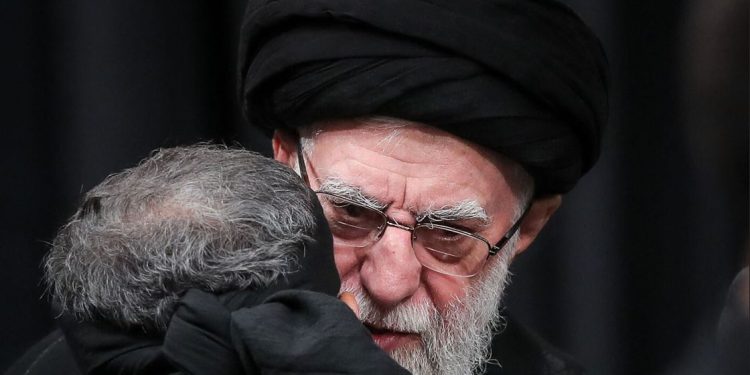Summer War 2025: Khamenei on Abdel Nasser’s Path of 1967
By Mohammad Sayed Rassas
The clouds of war gather slowly, sometimes invisibly, and then their fires rain down. It can be said that the Israel-Iran war took 20 months (since October 7, 2023) to get prepared. If it weren’t for the exposure of Iran’s military weakness through its two strikes on Israel in April and October of last year, and if it weren’t for the defeat of its allies in the Gaza and Lebanon wars, and the subsequent fall of its ally’s regime in Damascus, this war would not have erupted.
What Israeli Prime Minister Benjamin Netanyahu mentioned in his morning speech about Iran taking “unprecedented steps toward the militarization of enriched uranium” in recent months could be the direct reason that prompted Washington to give Tel Aviv the green light after months of reluctance by US President Donald Trump, rather than the deeper reason behind it, which can be inferred from American behavior in the war and its contrast with Israel’s. It was clear that Trump, unlike Netanyahu, did not want to overthrow the Iranian regime. Rather, he sought to contain it through political means, translating the military consequences of the war— which were clearly tilted strongly against Tehran.
Washington’s decision to limit itself to a single strike on three nuclear facilities, followed by a publicly imposed ceasefire agreement with Israel the next day, was highly indicative of an American intention to negotiate or explore the extent of Iran’s response to the new realities on the ground. Numerous indications leaked to Israeli newspapers suggest that Netanyahu was dissatisfied with this scenario pursued by Trump.
In this regard, many analysts attribute American behavior to fears of a recurrence of chaos in Iran similar to what was seen in Iraq, Libya, and Yemen, and to fears that Iranian chaos would have a greater impact across multiple regions—from the Middle East to the Caucasus and Central Asia, all the way to Pakistan and Afghanistan. However, it is important to remember what the last US ambassador to the Soviet Union said: “Washington was surprised by the dissolution of the Soviet Union and did not seek it.” Instead, it aimed to contain Mikhail Gorbachev, who was generous in his concessions, including his 1990 reversal of the Soviet opposition to German unification, which had existed since the days of Joseph Stalin, and his refusal to link it to a unified Germany’s withdrawal from NATO.
Most likely, Ali Khamenei agrees with Friedrich Engels’ statement, the one who harshly suppressed the student rebellion in 1999 and the Green Revolution in 2009. “any government that allows a hostile movement seeking to overthrow it to operate within the framework of the law is doomed to failure.” He is now compelled to make major concessions to Trump regarding the nuclear program, missile arsenal, regional policies, and international relations—particularly with China and Russia—while maintaining his grip on the internal Iranian scene.
Meanwhile, Washington is betting on the emergence of an Iranian Gorbachev, with a weak Khamenei or after his death (born in 1939 and ill). Many visitors to Iran note that its young men and women are among the least religious in the Middle East and are most inclined toward the Western liberal model. This recalls the impressions of Western journalists who visited Moscow during Gorbachev’s time, who perceived stronger liberal tendencies among Soviet technocrats than in their Western counterparts.
Without the above, it is impossible to explain Trump’s call for the Iranians to negotiate on the day the war ends. His threat to resume the war, along with Iran’s threatening measures—such as withdrawing from the IAEA or resuming enrichment—indicate that the prospects for negotiation are greater than the chances of a return to war for both Trump and Khamenei. This is different for Netanyahu, who demonstrated during the June 2025 war how much Tel Aviv needs Washington, and how Trump played the role of a football referee who blows the starting whistle and then ends the match at the exact moment he chooses, rebuking both teams.
From the war, several conclusions can be drawn. The first is that the United States, after the Hamas attack, abandoned Barack Obama’s policy of withdrawing from the Middle East and focusing on the Far East to counter China’s rise. This policy was accompanied by a more lenient approach toward Iran regionally, while allowing Moscow to establish a presence in Syria and Libya. Today, it appears that the trend is moving toward building a new Middle East with a “Middle Eastern NATO,” something that cannot be achieved without regionally containing Iran and reducing Russia’s influence in Syria and Libya.
The second conclusion is that the sun of Khomeini-Khamenei Iran, with its ideological and political currents, seems to be setting in the region after the summer war of 2025. This mirrors what happened with Nasserist Egypt after the 1967 summer war, when Abdel Nasser’s ally in North Yemen, Abdullah al-Sallal, fell, as did his Iraqi ally, Abdul Rahman Arif, whose loyalists in South Yemen were unable to take power after the British withdrawal.
The third conclusion is that this war has shattered concepts such as the “weakening of American power” and the “emergence of a multipolar world,” which were promoted by the Russians, Chinese, and Iranians during the period between the Ukrainian war and the Hamas attack. Hamas based its attack on these concepts and similar ideas, such as the notion that Israel is “weaker than a spider’s web.”




Comments are closed.